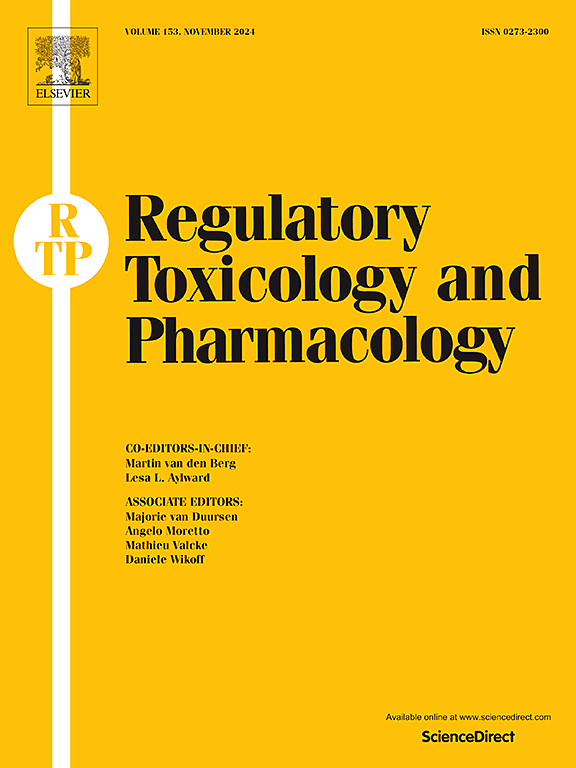硅学毒理学方法中不确定性来源的分类框架:对化学毒性预测的考虑。
IF 3
4区 医学
Q1 MEDICINE, LEGAL
引用次数: 0
摘要
要提高监管机构对用于化学品风险评估的硅学毒理学方法的信心和接受程度,就需要对相关的不确定性进行评估。因此,有必要对与方法及其预测相关的不确定性来源进行识别和系统分类。在本研究中,我们分析了对常用硅学毒理学方法的不确定性来源进行定性的研究。我们的研究显示,这些研究涵盖的不确定性来源的种类和数量各不相同。此外,这些研究使用了不同的术语来描述类似的不确定性来源;因此,大多数不确定性来源存在很大重叠。在现有框架的基础上,我们开发了一个新的不确定性分类框架,对所分析研究中描述的不同不确定性源进行了系统整合和分类。然后,我们通过一个涉及五种化合物毒性 QSAR 预测的案例研究来说明所开发框架的重要性,并将其与 QSAR 评估框架 (QAF) 进行比较。该框架可以让人们有条理地(并有可能更加透明地)理解硅毒理学模型和模型预测中的不确定性所在,从而促进对解决不确定性的适当策略进行批判性思考。本文章由计算机程序翻译,如有差异,请以英文原文为准。
A framework for categorizing sources of uncertainty in in silico toxicology methods: Considerations for chemical toxicity predictions
Improving regulatory confidence and acceptance of in silico toxicology methods for chemical risk assessment requires assessment of associated uncertainties. Therefore, there is a need to identify and systematically categorize sources of uncertainty relevant to the methods and their predictions. In the present study, we analyzed studies that have characterized sources of uncertainty across commonly applied in silico toxicology methods. Our study reveals variations in the kind and number of uncertainty sources these studies cover. Additionally, the studies use different terminologies to describe similar sources of uncertainty; consequently, a majority of the sources considerably overlap. Building on an existing framework, we developed a new uncertainty categorization framework that systematically consolidates and categorizes the different uncertainty sources described in the analyzed studies. We then illustrate the importance of the developed framework through a case study involving QSAR prediction of the toxicity of five compounds, as well as compare it with the QSAR Assessment Framework (QAF). The framework can provide a structured (and potentially more transparent) understanding of where the uncertainties reside within in silico toxicology models and model predictions, thus promoting critical reflection on appropriate strategies to address the uncertainties.
求助全文
通过发布文献求助,成功后即可免费获取论文全文。
去求助
来源期刊
CiteScore
6.70
自引率
8.80%
发文量
147
审稿时长
58 days
期刊介绍:
Regulatory Toxicology and Pharmacology publishes peer reviewed articles that involve the generation, evaluation, and interpretation of experimental animal and human data that are of direct importance and relevance for regulatory authorities with respect to toxicological and pharmacological regulations in society. All peer-reviewed articles that are published should be devoted to improve the protection of human health and environment. Reviews and discussions are welcomed that address legal and/or regulatory decisions with respect to risk assessment and management of toxicological and pharmacological compounds on a scientific basis. It addresses an international readership of scientists, risk assessors and managers, and other professionals active in the field of human and environmental health.
Types of peer-reviewed articles published:
-Original research articles of relevance for regulatory aspects covering aspects including, but not limited to:
1.Factors influencing human sensitivity
2.Exposure science related to risk assessment
3.Alternative toxicological test methods
4.Frameworks for evaluation and integration of data in regulatory evaluations
5.Harmonization across regulatory agencies
6.Read-across methods and evaluations
-Contemporary Reviews on policy related Research issues
-Letters to the Editor
-Guest Editorials (by Invitation)

 求助内容:
求助内容: 应助结果提醒方式:
应助结果提醒方式:


